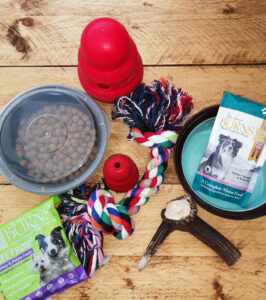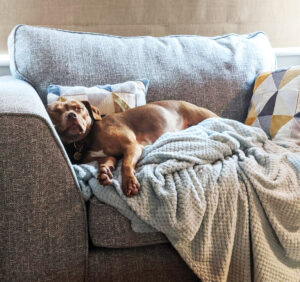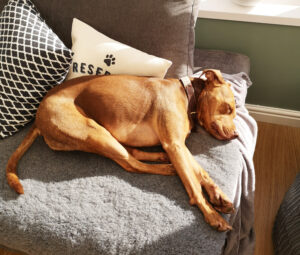
Dog food adviser, nutrition manager and lover of all things with paws, Laura shares her experience moving house for the first time with her anxious rescue pup, Amber.
Moving house is one of the most stressful things you can do as a human. You have to find a new place, pack your old stuff into boxes, dust off your label maker (if you’re organised enough to own one!) and unpack your whole life in an entirely new location without breaking a dish. All while remembering to forward your new address to your credit card company and your estranged great Nan. So, if moving home is this stressful for us, you can imagine how stressful it is for our pets.
I picked Amber up in a local rescue centre a few years ago. She’s a lovely staffie cross with a heart of gold and a face that would make Cruella de Vil weak at the knees. Unfortunately, she does suffer from a little anxiety at times, so I was really concerned about how she would cope in a new house. Luckily, I found some great methods to make the whole process as stress-free as possible:

Keep an overnight bag with some healthy dog food, chews, treats, their favourite toys and any medication they need so that you have them to hand when you move.
Even if you take all the recommended moving advice on board, list the contents on the top of each of your moving boxes and add the room where they belong in big black letters, you can still find it hard to find anything when you arrive at your new place. This is where an overnight bag for your pupper could come in handy.
Amber always looks forward to her Penlan Farm wet dog food every night and because we packed everything in her little ‘doggy’ bag, we could easily get her food ready for her usual feeding time.
Amber doesn’t have a bed, she has beds, and we made sure all of this was set up before she arrived. Having a bed and blankets with her scent on was a great way to make her comfortable in a new space full of confusing new smells and noises.
At Burns, I’m lucky enough to be able to bring Amber to work with me. On moving day, this was extra handy because I could keep her out of the way while most of the packing was done. If you’re able to keep your dog out of the way for the day whilst moving, I would definitely recommend doing so.
Before I took Amber to our new house, I set out her bed in the living room and her sleeping crate in the bedroom so that she had somewhere to go in the new house if she was feeling stressed.
Amber is a nervous pup at times, which has given us plenty of opportunities to try to comfort her with some healthy remedies. Adaptil makes plug in diffusers that help dogs and puppies feel calm and relaxed at home. I kept one in Amber’s overnight bag so that I could plug it in at the new house as soon as we got there.
I also tried some herbal calming tablets. Amber took these for a couple of months before we moved and she carried on with them in our new house. Natural calming tablets often contain ingredients such as chamomile or skullcap and Valerian, which aren’t harmful to your pupper.
For the most anxious pooches, you could also try an anxiety vest. An anxiety vest often works well to calm Amber down, but luckily, we didn’t need one on this occasion because Amber coped quite well without it.
Like humans, kids, and The Kardashians, dogs love to keep to their routine. Keeping up with your pupper’s usual meal, walk and bedtime can help them feel more relaxed in a new house. It’ll give them a normal structure, which can do wonders to reduce your dog’s anxiety.
Amber did seem a little lost when we first moved; she didn’t have her usual spots to snuggle and relax in, but she quickly found new ones. She has kept up her previous routine and always makes sure she reminds me when it’s close to teatime.

When you’re switching over your bills and making sure your friends and family can find you in your new place, it’s worth making sure your dog’s address is updated too.
We had a tag ready for Amber’s collar with our new address and contact number on. We also made sure we contacted the microchip company to update our address on their system. This way, we could be reunited with Amber if she were to go missing.
It takes about three months for a pup to get used to a new pad. It can be stressful, but with a little bit of preparation you can help them get settled sooner. It’s been a few months for Amber and me, and luckily, she’s now completely settled. She loved her new home, has found all the sunny spots where she can nap, and even knows the best place to perch herself so she can shout at the postman and keep an eye on the neighbours.

For free advice and guidance on getting your dog settled into a new environment, contact our advice and nutrition teams today.







